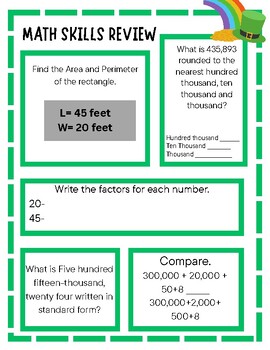4th Grade Math St. Patrick's Day Spring Skills Worksheets/Spiral Review Packet
The Math EduKaytor
7 Followers
Grade Levels
4th
Subjects
Resource Type
Standards
CCSS4.MD.A.3
CCSS4.NBT.A.2
CCSS4.NBT.A.3
CCSS4.NBT.B.4
CCSS4.NF.A.1
Formats Included
- PDF
Pages
10 pages
The Math EduKaytor
7 Followers
Also included in
- This bundle contains 10 different products that will help your students master their math skills! Included are:5 different Fraction to Decimal mystery word activitiesWeekly Skills Review for the month2 Color by number fraction to decimal activities1 Weekly skills calendar1 Analyzing Patterns workshePrice $21.60Original Price $24.00Save $2.40
Description
These review worksheets are St. Patrick's Day Themed perfect to give to your students in the month of March! There are 4 worksheets, 1 for each week to help your students practice several math skills taught throughout the year. These review worksheets have adding and subtracting, equivalent fractions, rounding, place value, area and perimeter and so much more! Answer Keys are included with purchase.
Total Pages
10 pages
Answer Key
Included
Teaching Duration
1 month
Report this resource to TPT
Reported resources will be reviewed by our team. Report this resource to let us know if this resource violates TPT’s content guidelines.
Standards
to see state-specific standards (only available in the US).
CCSS4.MD.A.3
Apply the area and perimeter formulas for rectangles in real world and mathematical problems. For example, find the width of a rectangular room given the area of the flooring and the length, by viewing the area formula as a multiplication equation with an unknown factor.
CCSS4.NBT.A.2
Read and write multi-digit whole numbers using base-ten numerals, number names, and expanded form. Compare two multi-digit numbers based on meanings of the digits in each place, using >, =, and < symbols to record the results of comparisons.
CCSS4.NBT.A.3
Use place value understanding to round multi-digit whole numbers to any place.
CCSS4.NBT.B.4
Fluently add and subtract multi-digit whole numbers using the standard algorithm.
CCSS4.NF.A.1
Explain why a fraction 𝘢/𝘣 is equivalent to a fraction (𝘯 × 𝘢)/(𝘯 × 𝘣) by using visual fraction models, with attention to how the number and size of the parts differ even though the two fractions themselves are the same size. Use this principle to recognize and generate equivalent fractions.






